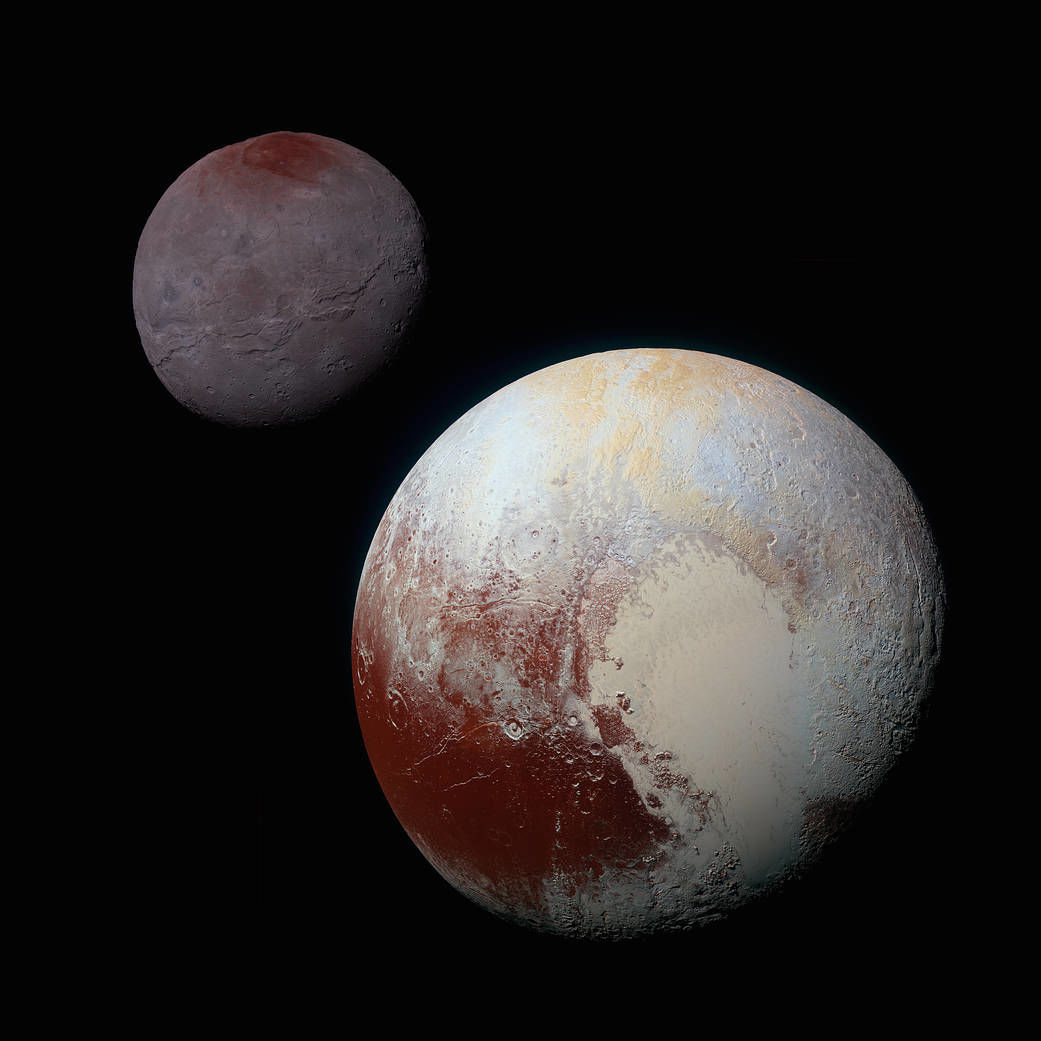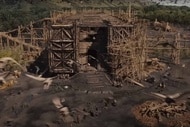Create a free profile to get unlimited access to exclusive videos, sweepstakes, and more!
Science Behind the Fiction: How Pluto made the solar system bigger

Thirteen years ago, today, Pluto received a demotion. Nothing had changed about the icy world itself, but our understanding of the solar system had grown and new questions had arisen. This amounted to one of the most drastic changes in the public understanding of our solar system. And it all ties back to a little trans-neputunian world called Eris.
Why Pluto was Reclassified
Discovered in 2005, astronomers at first believed Eris to be larger than Pluto, sparking debate about whether or not it should be named as the tenth planet. Astronomers were forced to take a closer look at what it means to be a planet, as opposed to something else. Eris is positioned in the Kuiper Belt, a region of space containing icy remnants from the early formation of the solar system.
When the sun was young,and the solar system little more than a cloud of dust and energy, matter pulled together under the force of gravity, forming planets, moons, and smaller objects--the solar system as we know it--but beyond the orbit of Neptune, matter was far enough away to avoid capture and accretion.
Astronomers believe this region of space may be home to more than a hundred objects similar to Pluto. Eris is one of these. It is so far distant, it takes 561 years to orbit the sun. All of this called into question the way we define and classify the objects in our stellar neighborhood.
The International Astronomical Union had a decision to make. Do we add a new planet, potentially opening the door to dozens or hundreds more, or do we create a new classification and lose Pluto in the process?
In 2006, they landed on reclassification and the ripples that decision, sent through the astronomical community, and the world, are still being felt.
The decision was made that, in order for a body to attain planetary status, it had to meet certain criteria.
What Makes up a Planet?
First, it must orbit the sun. Simple enough.
Second, it must have sufficient mass to pull itself into a spheroid shape.
Third, it must not be a satellite of any other object. This one is important. If planetary status were defined by the previous two criteria alone, there would be a great many planets to add to our model. Our own moon meets those criteria. Many of the moons orbiting the gas giants meet those criteria and are, in fact, more massive and more complex than some of the existing planets.
Finally, it must gravitationally dominate its local neighborhood.
These last two rules are where Pluto hit a snag. It’s relationship to it’s largest moon, Charon, is such that they orbit one another in a binary system, around a common point outside the mass of Pluto. In a sense, this means that while Charon is a satellite of Pluto, Pluto is also a satellite of Charon. It also isn’t considered to have cleared its region in the same way other planets have. This is something of a point of contention as no planet has truly “cleared” its neighborhood. Objects come into proximity and into contact with planets all the time. Anyone who has seen a shooting star can attest to that. And if you’re still in doubt, just ask the dinosaurs.
What it really comes down to is the realization that our solar system is much more complex than we previously imagined and we’re just not very good at defining and classifying things which don’t have clear, demonstrable boundaries.
What was, perhaps, the most surprising discovery to come out of that 2006 meeting of the IAU was not the reclassification of Pluto but the huge public outcry. People, it seems, love Pluto, and they considered it a shock and a personal insult to slight it in this way. This sentiment has been solidified by the findings of the New Horizons mission which visited the far-distant world, returning stunning photos and a whole host of new information.
The Upside
This raucous public conversation and controversy about the status of Pluto among its celestial companions hasn’t been all bad. It’s led to a period of high public interest in astronomy. In one of the greatest examples of the old adage, “no publicity is bad publicity,” the public at large has become engaged in the exploration and understanding of the solar system in a way that hasn’t been seen in decades.
While the outrage stems from a sense that our solar system has, in some ways, become smaller, the opposite is actually true. Where before, we sat perched on the third of nine planets, now we are part of a richer and more complex system. One which includes five dwarf planets and, if our models are correct, many more to come.
At current, Pluto is the largest of five known dwarf-planets, each of them interesting in their own ways and worthy of study and public awareness. Pluto was once beloved because it proved there was more to discover. There was more out there to see and understand. And it’s new position doubles down on that notion. Instead of being the newest and smallest of the known worlds, it is now the poster-child for a whole new type of world.
Pluto
Let’s start with the King. Not much was known about Pluto before the New Horizons mission, but since its arrival at the near-edge of the solar system, our understanding has grown drastically. It’s orbit is highly erratic. Pluto orbits at odds with the celestial plane and actually intersects the orbit of Neptune, sometimes bringing it in closer to the sun than the eighth planet.
That, in and of itself, makes Pluto unique but the truly stunning revelations came when we got up close and personal.
New Horizons revealed a world both beautiful and full of activity.
It’s most apparent feature is a heart-shaped glacier the size of Texas and Oklahoma on its face.
It addition to this incredible geological feature, it has areas free of impact craters suggesting geological activity and fairly young surface.
West of the heart-shaped region is an area called Cthulhu Macula which houses mountains rivaling the Rockies where blood-red methane snow falls. It’s an environment so alien even Lovecraft might have fallen into madness at the sight of it. Whatever classification we ultimately bestow upon Pluto, there’s no denying its splendor.
Eris
Eris is nearly the twin of Pluto in size. Named for the Greek god of discord--a fitting name considering all the trouble it stirred up--Eris also lies in the Kuiper Belt. It is one of the most reflective bodies in the solar system, bouncing back nearly 96% of the light that reaches it. It is believed it has an atmosphere of nitrogen and methane only a millimeter thick which fluctuates between solid and gaseous states as the dwarf-planet’s orbit takes it closer to and farther away from the sun.
At the time of its discovery, there was a possibility it would become the tenth planet. It was not given that honor, but was responsible for the new designation, of which Pluto became a part.
Haumea
Haumea, named for the Hawaiian goddess of fertility, is approximately 385 miles in radius, roughly one forteenth the size of Earth. It orbits at a distance of 43 AU (the average distance from the sun to Earth) and takes 285 years to complete an orbit.
Haumea is unique among the dwarf planets, owing to its shape. Instead of being spherical, it has a shape more akin to a football. This is a result of its fast rotation. It revolves on its own axis every for hours. The outward force generated by the spin is at war with its own gravity, causing it to splay out like a child being spun by the arms. It’s furious spin is believed to be the result of an ancient impact with another object, one that also created its moons. It is also the first known Kuiper object which has rings.
Makemake
Makemake (mah-kee-mah-kee), like Eris, was discovered in 2005 and is named for the Rapa Nui god of fertility. Like the rest of the dwarf-planets listed so far, Makemake orbits in the Kuiper Belt taking more thatn 300 years to complete an orbit. It is fairly reflective but has a moon black as charcoal.
Ceres
Ceres is the final officially recognized dwarf-planet to-date. It has the honor of being the first dwarf-planet discovered, being first observed in 1801. It differs from the others of its classification in being the only one which lies within the inner solar system.
Ceres orbits between Mars and Jupiter, in the asteroid belt. It was, for a long time, considered to be the largest asteroid there, making up approximately a quarter of all the matter in the belt. Still, it is small. Pluto is fourteen times as massive. It has no atmosphere or moons. It was, however, the first dwarf-planet to be directly studied. The Dawn mission reached it in 2015.
What’s most startling is the relative obscurity of Ceres in the more than two centuries since it was first discovered. This likely owes to our classification of things, something the demotion of Pluto changed.
While reclassifying Pluto caused waves the world over, it shined a spotlight on these other worlds, something which might not have happened otherwise, and that’s a worthwhile legacy. Pro-Pluto proponents, however, still have hope. The debate about the status of Pluto and the rest of the dwarf-planets is still ongoing. Many within the astronomical community have challenged the classification and believe planetary status should be restored to Pluto and expanded to others.
Maybe one day in the future, children will learn about the dozens or hundreds of worlds in our solar system and be inspired to study them. That can only be a good thing, whatever we call them.
















